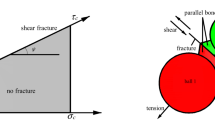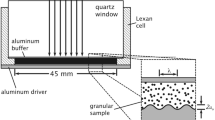Abstract
While dynamic comminution is of interest to many processes and situations, this work is focused on the projectile impact onto concrete walls, in which predictions have been hampered by the problem of the so-called ‘dynamic overstress’. Recently, in analogy with turbulence, Bažant and Caner modeled the overstress as an additional viscous stress generated by apparent viscosity that accounts for the energy dissipation due to kinetic comminution of concrete into small particles at very high shear strain rate. Their viscosity estimation, however, was approximate since it did not satisfy the energy balance exactly. Here their model is extended and refined by ensuring that the drop of local kinetic energy of high shear strain rate of forming particles must be exactly equal to the energy dissipated by interface fracture of these particles. The basic hypothesis is that the interface fracture occurs instantly, as soon as the energy balance is satisfied. Like in the preceding work, this additional apparent viscosity is a power function of the rate of the deviatoric strain invariant. But here the power exponent is different, equal to \(-7/3\), and the apparent viscosity is found to be proportional also to the time derivative of the rate of that invariant, i.e., to the second derivative of the shear strain. It is assumed that the interface fracture that comminutes the material into small particles occurs instantly, as soon as the local kinetic energy of shear strain rate in the forming particles becomes equal to the energy required to form interface fractures. The post-comminution behavior, including subsequent further comminution and clustering into bigger particle groups to release the kinetic energy that is being dissipated by inter-group friction, is discussed and modeled. The present formulation makes it possible to eliminate the artificial damping of all types, which is normally embedded in commercial finite element codes but is not predictive since it is not justified physically. With the aforementioned improvements, and after implementation into the new microplane model M7 for fracturing damage in concrete (which includes the quasi-static rate effects), the finite element predictions give superior agreement with the measured exit velocities of steel projectiles penetrating concrete walls of different thicknesses and with the measured depths of penetration into concrete blocks by projectiles of different velocities. Finally it is pointed out that the theory presented may also be used to predict proximate fragmentation and permeability enhancement of gas shale by powerful electric pulsed-arc explosions in the borehole.





Similar content being viewed by others
References
Adley MD, Frank AO, Danielson KT (2012) The high-rate brittle microplane concrete model: Part I: bounding curves and quasi-static fit to material property data. Comput Concr 9:293–310
Bažant ZP, Caner FC, Carol I, Adley MD, Akers SA (2000) Microplane model M4 for concrete. I: formulation with work-conjugate deviatoric stress. J Eng Mech 126:944–953
Bažant ZP, Caner FC (2013) Comminution of solids caused by kinetic energy of high shear strain rate, with implications for impact, shock, and shale fracturing. Proc Natl Acad Sci 110:19291–19294
Bažant ZP, Caner FC (2014) Impact comminution of solids due to local kinetic energy of high shear strain rate: I. Continuum theory and turbulence analogy. J Mech Phys Solids 64:223–235
Bažant ZP, Su Y (2015) Impact comminution of solids due to progressive crack growth driven by kinetic energy of high-rate shear. ASME J Appl Mech 82:031007-1–031007-5
Cadoni E, Labibes K, Albertini C, Berra M, Giangrasso M (2001) Strain-rate effect on the tensile behaviour of concrete at different relative humidity levels. Mater struct 34:21–26
Camacho G, Ortiz M (1996) Computational modelling of impact damage in brittle materials. Int J Solids Struct 33:2899–2938
Caner FC, Bažant ZP (2000) Microplane model M4 for concrete. II: algorithm and calibration. J Eng Mech 126:954–961
Caner FC, Bažant ZP (2012a) Microplane model M7 for plain concrete. I: formulation. J Eng Mech 139:1714–1723
Caner FC, Bažant ZP (2012b) Microplane model M7 for plain concrete. II: calibration and verification. J Eng Mech 139:1724–1735
Caner FC, Bažant ZP (2014) Impact comminution of solids due to local kinetic energy of high shear strain rate: II. Microplane model and verification. J Mech Phys Solids 64:236–248
Cargile JD (1999) Development of a constitutive model for numerical simulation of projectile penetration into brittle geomaterials. DTIC Document
Charles RJ (1957) Energy-size reduction relationships in comminution. Trans Am Inst Min Metall Eng 208:80–88
Deshpande V, Evans A (2008) Inelastic deformation and energy dissipation in ceramics: a mechanism-based constitutive model. J Mech Phys Solids 56:3077–3100
Doyoyo M (2002) A theory of the densification-induced fragmentation in glasses and ceramics under dynamic compression. Int J Solids Struct 39:1833–1843
Ferri E, Deshpande V, Evans A (2010) The dynamic strength of a representative double layer prismatic core: a combined experimental, numerical, and analytical assessment. J Appl Mech 77:061011
Forquin P, Gary G, Gatuingt F (2008) A testing technique for concrete under confinement at high rates of strain. Int J Impact Eng 35:425–446
Frank AO, Adley MD, Danielson KT, McDevitt HS Jr (2012) The high-rate brittle microplane concrete model: Part II: application to projectile perforation of concrete slabs. Comput Concr 9:311–325
Freund LB (1990) Dynamic fracture mechanics. Cambridge University Press, Cambridge
Gailly BA, Espinosa HD (2002) Modelling of failure mode transition in ballistic penetration with a continuum model describing microcracking and flow of pulverized media. Int J Numer Methods Eng 54:365–398
Gatuingt F, Pijaudier-Cabot G (2002) Coupled damage and plasticity modelling in transient dynamic analysis of concrete. Int J Numer Anal Methods Geomech 26:1–24
Grady D, Kipp M (1979) The micromechanics of impact fracture of rock. Int J Rock Mech Min Sci Geomech Abstr 16:293–302
Grady D (1982) Local inertial effects in dynamic fragmentation. J Appl Phys 53:322–325
Grady DE (1990) Particle size statistics in dynamic fragmentation. J Appl Phys 68:6099–6105
Grady D, Kipp M (1995) Experimental measurement of dynamic failure and fragmentation properties of metals. Int J Solids Struct 32:2779–2791
Grady D (1998) Shock-wave compression of brittle solids. Mech Mater 29:181–203
Hemmert DJ, Smirnov VI, Awal R, Lati S, Shetty A (2010) Pulsed power generated shockwaves in liquids from exploding wires and foils for industrial applications. In: Proceedings of the 16th International Symposium on High Current Electronics, Tomsk, Russia, pp 537–540
Kožar I, Ožbolt J (2010) Some aspects of load-rate sensitivity in visco-elastic microplane material model. izlazi u samo elektronikom izdanju: NE
Maurel O, Reess T, Matallah M, De Ferron A, Chen W, La Borderie C, Pijaudier-Cabot G, Jacques A, Rey-Bethbeder F (2010) Electrohydraulic shock wave generation as a means to increase intrinsic permeability of mortar. Cem Concr Res 40:1631–1638
Mescall J, Weiss V (1984) Materials behavior under high stress and ultrahigh loading rates Part II, In: Proceeding of 29th Sagamore Army Conference. Army Materials and Mechanics Center, Watertown, MA
Mott N (1947) Fragmentation of shell cases. Proce R Soc Lond Ser A Math Phys Sci 189:300–308
Ouchterlony F (2005) The Swebrec function: linking fragmentation by blasting and crushing. Min Technol 114:29–44
Ožbolt J, Sharma A, Reinhardt H-W (2011) Dynamic fracture of concrete compact tension specimen. Int J Solids Struct 48:1534–1543
Schuhmann R Jr (1940) Principles of comminution, I-size distribution and surface calculations. AIME Technical Publication, Los Angeles 1189
Shih C, Nesterenko V, Meyers M (1998) High-strain-rate deformation and comminution of silicon carbide. J Appl Phys 83:4660–4671
Wei Z, Evans A, Deshpande V (2009) The influence of material properties and confinement on the dynamic penetration of alumina by hard spheres. J Appl Mech 76:051305
Acknowledgments
Support during the initial phase of research under grant W911NF-09-1-0043/P00003 from the U.S. Army Research Office, Durham, to Northwestern University, is gratefully acknowledged. So is an additional support obtained from the ADD, Korea, through a Daejeon University grant to Northwestern University. Thanks are due to Ferhun Caner, Visiting Scholar on leave from UPC, Barcelona, for making available his coding of M7 and the meshes for slab perforations.
Author information
Authors and Affiliations
Corresponding author
Additional information
Yewang Su was on leave from State Key Laboratory of Nonlinear Mechanics, Institute of Mechanics, Chinese Academy of Sciences, Beijing 100190, China.
Youxuan Zhao was on leave from School of Civil Engineering, Southwest Jiaotong University, Chengdu, China.
Rights and permissions
About this article
Cite this article
Su, Y., Bažant, Z.P., Zhao, Y. et al. Viscous energy dissipation of kinetic energy of particles comminuted by high-rate shearing in projectile penetration, with potential ramification to gas shale. Int J Fract 193, 77–85 (2015). https://doi.org/10.1007/s10704-015-0019-0
Received:
Accepted:
Published:
Issue Date:
DOI: https://doi.org/10.1007/s10704-015-0019-0




